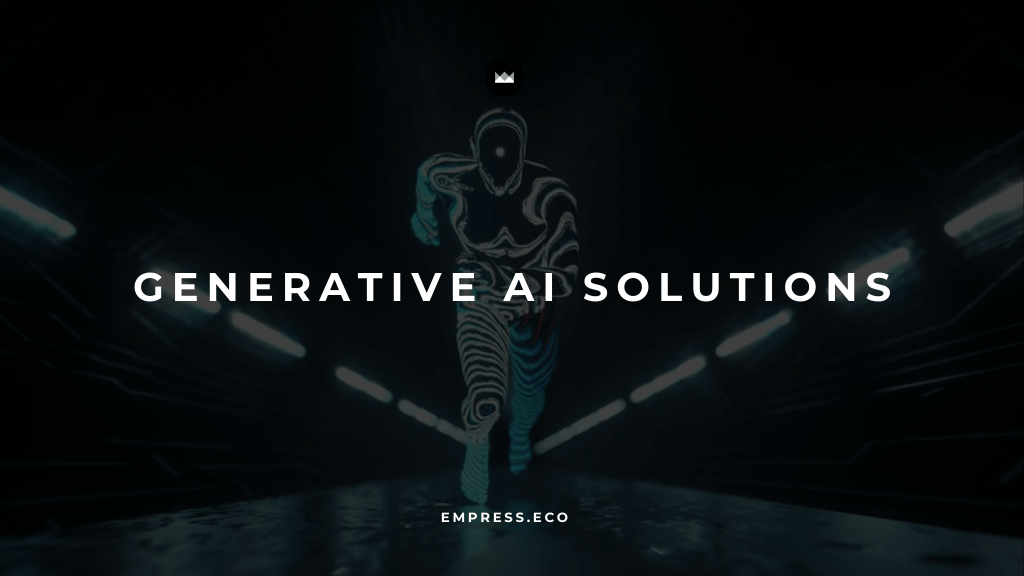
Applying Generative AI to Business Challenges
Discover how AI-driven automation is transforming business efficiency and driving growth.
Table of Contents
Running a business often feels like you’re in a constant balancing act—keeping customers happy, staying ahead of the competition, and managing day-to-day operations, all while trying to innovate and grow. It’s no wonder that business owners and managers are always on the lookout for tools that can make their lives easier. Generative AI is one such tool, and while it might sound a bit futuristic or complex, it’s surprisingly accessible and practical, especially when it comes to solving common business challenges.
In this guide, we’ll dive into how Generative AI can be applied to your specific business environment, focusing on practical use cases that you can implement immediately. By the end, you’ll have a clear understanding of how AI can help you streamline operations, enhance customer interactions, and even unlock new opportunities for growth.
Step 1: Identifying the Core Challenges in Your Business
Before we start talking about how Generative AI can help, it’s important to first identify the challenges you face in your business. This is a critical step because it helps you focus on the areas where AI can make the most impact.
Think about the daily operations of your business. Where do you encounter the most frustration? What tasks feel repetitive, draining, or time-consuming? Where do you wish you had more time or resources?
Here are a few common areas where businesses often struggle:
- Content Creation:
- Are you spending too much time creating blog posts, social media updates, or marketing emails?
- Do you find it challenging to keep your brand’s voice consistent across different platforms?
- Are you struggling to come up with fresh, engaging content ideas regularly?
- Customer Interaction:
- Is your customer service team overwhelmed with repetitive inquiries?
- Could your business benefit from a more personalized approach to customer communication?
- Are you finding it difficult to maintain timely and efficient customer interactions?
- Process Optimization:
- Are there routine tasks in your business that take up too much time and could be automated?
- Do you face challenges in forecasting demand, managing inventory, or scheduling?
- Are your business processes as efficient as they could be?
By identifying these challenges, you’ll be better equipped to see where Generative AI can step in to help. The key is to focus on areas that are both important and time-consuming, where AI can deliver immediate value.
Step 2: Exploring How Generative AI Can Address These Challenges
Once you’ve pinpointed the challenges, the next step is to explore how Generative AI can be applied to address them. Let’s break it down into three main areas where AI can have a significant impact: content creation, customer interaction, and process optimization.
Use Case 1: Streamlining Content Creation
Creating high-quality content is a critical part of running any business, especially in today’s digital-first world. Whether you’re writing blog posts, updating your website, crafting email campaigns, or managing social media accounts, content creation can be incredibly time-consuming. This is where Generative AI can be a game-changer.
How Generative AI Can Help:
Imagine you’re about to launch a new product, and you need to create a series of marketing materials—blog posts, social media updates, product descriptions, and emails. Typically, this would require hours of brainstorming, drafting, revising, and finalizing content to ensure it’s consistent with your brand’s voice and message.
Generative AI can dramatically speed up this process. By inputting a few key details—such as the product features, your target audience, and the desired tone of voice—the AI can generate drafts for you. These drafts serve as a solid foundation, which you can then tweak and refine, saving you a significant amount of time.
Example:
Let’s say you run an online store that specializes in eco-friendly products, and you’re introducing a new line of sustainable backpacks. Normally, writing a product description might take you 30 minutes or more, especially if you’re aiming to highlight the product’s unique selling points while maintaining a consistent tone.
Here’s how you could use Generative AI to simplify the process:
- Input Key Information:
- Product Name: Eco-Trek Backpack
- Features: Made from recycled materials, water-resistant, ergonomic design
- Target Audience: Environmentally conscious travelers
- Tone of Voice: Friendly and informative
- Generate the Content:The AI processes this information and generates a product description like this:
- "Introducing the Eco-Trek Backpack—your ultimate companion for sustainable travel. Crafted from 100% recycled materials, this backpack combines durability with eco-friendly design. Its water-resistant finish and ergonomic construction make it perfect for any adventure, whether you’re exploring city streets or hitting the trails. Choose the Eco-Trek Backpack and carry your values with you, wherever you go."
- Refine and Publish:With the draft in hand, you can make any necessary adjustments, ensuring it fits your exact needs. You’ve saved time, maintained consistency, and ensured that your content is aligned with your brand’s message.
This approach can be applied across various types of content—whether it’s social media posts, email campaigns, or blog articles—allowing you to maintain a steady flow of high-quality content without the usual stress.
Use Case 2: Enhancing Customer Interaction
Customer service is the backbone of any successful business, but it can also be one of the most resource-intensive areas. Managing customer inquiries, resolving issues, and maintaining engagement can take a lot of time, especially if your team is handling the same questions repeatedly. Generative AI can help by automating some of these interactions, providing instant responses, and freeing up your team to focus on more complex issues.
How Generative AI Can Help:
AI-powered chatbots are a perfect example of how Generative AI can enhance customer interaction. These chatbots can handle a wide range of customer inquiries, from answering simple questions to guiding customers through more complicated processes. The best part? They’re available 24/7, ensuring your customers always get the support they need, even outside of business hours.
Example:
Consider a scenario where you run an online clothing store. Your customers frequently ask about sizing, return policies, and delivery times. While these questions are important, they’re also repetitive and could easily be managed by an AI chatbot.
Here’s how you could implement this:
- Set Up the AI Chatbot:
- Common Inquiries: Identify the most common questions your customers ask, such as “What’s your return policy?” or “How do I track my order?”
- Pre-Loaded Responses: Input the answers to these questions into the chatbot, ensuring the responses align with your brand’s tone and provide clear, helpful information.
- Customer Interaction:When a customer visits your site and asks, “What’s your return policy?” the chatbot instantly responds with:
- "We want you to love what you ordered! If you’re not completely satisfied, you can return any item within 30 days for a full refund. Just make sure the items are in their original condition. Need help with a return? I’m here to guide you through the process."
- Handle Complex Inquiries:For more complex questions, the chatbot can forward the inquiry to a human agent, providing a seamless handoff and ensuring the customer receives the best possible service.
This setup not only improves the efficiency of your customer service but also enhances the overall customer experience by providing instant, accurate responses.
Use Case 3: Optimizing Business Processes
Beyond content creation and customer interaction, Generative AI can also play a critical role in optimizing your business processes. Whether it’s managing inventory, forecasting demand, or scheduling, AI can help streamline operations and improve decision-making.
How Generative AI Can Help:
Generative AI can analyze historical data, identify patterns, and generate predictions that help you make more informed decisions. This is particularly useful in areas like inventory management, where understanding demand trends can make the difference between stocking out and overstocking.
Example:
Imagine you’re managing a retail business, and one of your biggest challenges is maintaining the right inventory levels. You’ve noticed that certain products tend to sell out quickly during specific seasons, but predicting these trends accurately has been a struggle.
Here’s how Generative AI could help:
- Analyze Historical Data:
- Sales Data: The AI can analyze past sales data, looking at trends over time, seasonal fluctuations, and external factors like promotions or holidays.
- Customer Behavior: It can also consider customer behavior patterns, such as repeat purchases or changes in buying habits.
- Generate Predictions:Based on this analysis, the AI generates predictions for future demand, helping you identify which products are likely to be in high demand and when.
- Optimize Inventory:With these predictions, you can adjust your inventory levels, ensuring you have enough stock to meet customer demand without over-ordering. This reduces costs, minimizes waste, and improves customer satisfaction.
By using AI to optimize your processes, you can make more informed decisions, reduce inefficiencies, and ultimately improve your bottom line.
Step 3: Implementing Generative AI in Your Business
Now that you’ve seen how Generative AI can address specific business challenges, it’s time to think about how to implement these ideas in your own business. The key is to start small—focus on one or two areas where you can quickly see results and then gradually expand AI’s role as you become more comfortable with the technology.
Starting Small and Scaling Up
You don’t need to overhaul your entire business to start using AI. In fact, it’s better to start with a small, manageable project that allows you to see the benefits of AI in action without overwhelming your resources.
For Example:
- If content creation is a pain point, start by using AI to generate drafts for your blog posts or social media updates.
- If customer service is a bottleneck, implement a chatbot to handle routine inquiries.
- If managing inventory is challenging, use AI to help forecast demand and optimize stock levels.
As you start to see the benefits, you can explore other areas where AI might be useful, gradually integrating it into more aspects of your business.
Measuring the Impact
Once you’ve implemented AI in a specific area, it’s important to measure the impact. Did it save time? Improve efficiency? Enhance customer satisfaction? Gathering this data will help you understand the value AI brings and guide your decisions on where to expand its use.
For instance, if you used AI to generate content, track how much time was saved in the writing process, how often the AI-generated content was used without significant edits, and whether it improved engagement metrics like clicks or shares. If you implemented a chatbot, monitor the number of inquiries it handled and how it affected customer satisfaction scores.
By measuring these outcomes, you’ll have a clear picture of how Generative AI is benefiting your business and where there’s potential for further implementation.
Final Thoughts: Making Generative AI Your Business Ally
Generative AI is more than just a buzzword—it’s a powerful tool that can help you solve real-world business challenges. Whether it’s creating content, enhancing customer interaction, or optimizing processes, AI offers practical solutions that can make a real difference in your day-to-day work.
The best part? You don’t need to be a tech expert to get started. With the right approach, you can begin applying AI in your business today, see immediate benefits, and set the stage for even greater opportunities down the line.
So, take a look at your business, identify where the challenges lie, and consider how Generative AI could be the solution you’ve been looking for. As you explore and experiment, you’ll find that AI isn’t just a tool for the future—it’s an ally for your business today.
Empress Newsletter
Join the newsletter to receive the latest updates in your inbox.



